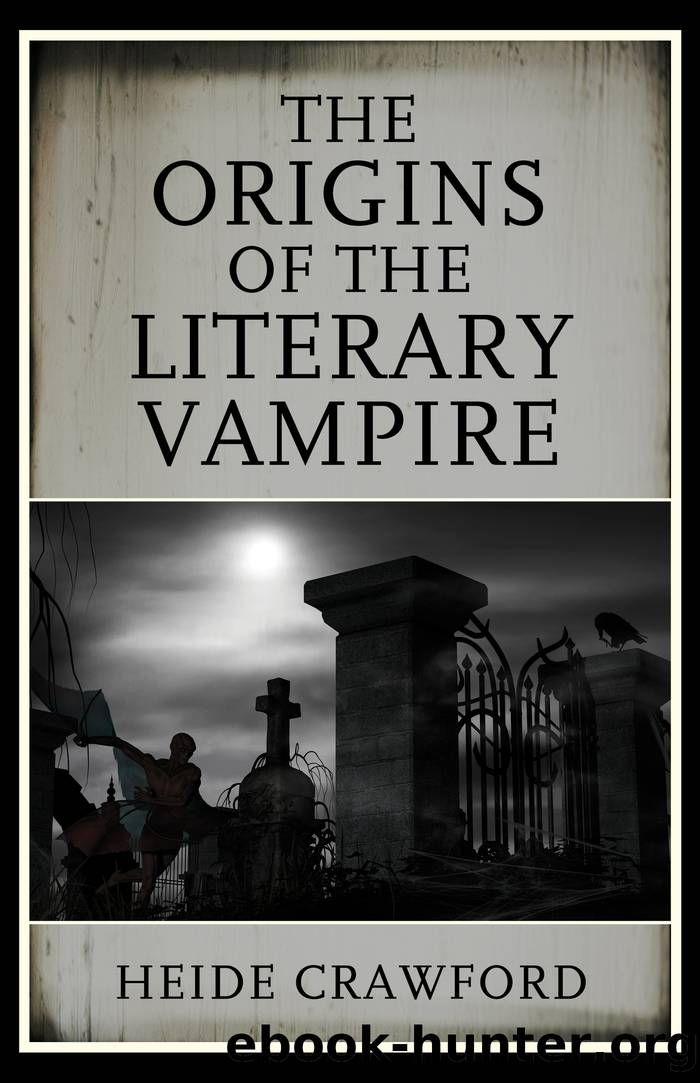The Origins of the Literary Vampire by Crawford Heide;

Author:Crawford, Heide;
Language: eng
Format: epub
Tags: undefined
Publisher: Rowman & Littlefield Unlimited Model
Published: 2012-08-15T00:00:00+00:00
Joseph Freiherr von Eichendorff: âDas kalte Liebchenâ (âThe Cold Sweetheartâ) and âDie späte Hochzeitâ (âThe Late Weddingâ)
Joseph Freiherr von Eichendorff wrote two poems that, in contrast to Goetheâs ballad, provide no explanation for the identities of the women in his poems as vampires. By the time Eichendorff wrote his vampire poems in 1816 and 1828, readers were very likely so familiar with the vampire from folklore and superstition as well as the literary vampire, popularized by Bürger, Goethe, and contemporary British poets such as John Polidori and Lord Byron, that there was no need for Eichendorff to explain how or why a person might become a vampire. The readersâ fascination with the vampire developed more from the suspense created by the interplay of the readersâ knowledge of the vampireâs identity and the victimâs ignorance of what lay ahead.
Though both women in Eichendorffâs poems are revenants, only the one in his poem, âThe Late Wedding,â is also a complete and intentional femme fataleâat least in one possible interpretation of her actions. Eichendorffâs ballad, âThe Cold Sweetheart,â is the first known German vampire poem that does not have as its focus the vampiric characteristics or actions of the revenant. Instead, the focus is on the impending tragic consequences for the young man who will join his vampire lover despite her warnings of his likely fate. As we have seen, Goetheâs bride in âThe Bride of Corinthâ goes into great detail when she explains her vampiric nature and preferred manner of death to her mother, albeit not until the end of the poem. By the time Eichendorff wrote âThe Cold Sweetheartâ in 1816, the motif of the revenant lover who later reveals his or her vampiric nature had already been popular for some time. For this reason, it was not necessary for Eichendorff to dwell on the details of his characterâs vampire nature, nor is it necessary to address how she became a vampire. It was enough for him to imply her vampiric nature by references, such as her âKämmerleinâ (little room) and how cold it is where she lies: âHier wirdâs noch viel kühler seinâ (Here it will be much cooler) (l.8) and especially that her lover must follow her to the grave: âMit ins Grab hinunter muÃâ (Will have to join me in the grave) (l.16).
In âThe Cold Sweetheart,â the man ignores repeated requests by the woman to stay away. The woman gives him several vague indications that she is in fact dead and lying in her coffin, but he is determined to lie down with her. Finally, when the witching hour is upon them (âSieh! Die Sterne schon erblassenâ [See! The stars are already fadingâ; l.9]), she feels herself falling into an altered state, a âslumberâ (l.10). The young man tries to embrace her and suffers from her kiss: âWahnsinn bringt der Toten KuÃâ (The kiss of the dead brings insanity; l.14). In the end she informs him that he must follow her to her grave: âMit ins Grab hinunter muÃâ (Will have to join me in the grave).
Download
This site does not store any files on its server. We only index and link to content provided by other sites. Please contact the content providers to delete copyright contents if any and email us, we'll remove relevant links or contents immediately.
4 3 2 1: A Novel by Paul Auster(12078)
The handmaid's tale by Margaret Atwood(7590)
Giovanni's Room by James Baldwin(7026)
Asking the Right Questions: A Guide to Critical Thinking by M. Neil Browne & Stuart M. Keeley(5521)
Big Magic: Creative Living Beyond Fear by Elizabeth Gilbert(5501)
Ego Is the Enemy by Ryan Holiday(5148)
On Writing A Memoir of the Craft by Stephen King(4778)
The Body: A Guide for Occupants by Bill Bryson(4774)
Ken Follett - World without end by Ken Follett(4540)
Adulting by Kelly Williams Brown(4387)
Bluets by Maggie Nelson(4385)
Eat That Frog! by Brian Tracy(4307)
Guilty Pleasures by Laurell K Hamilton(4224)
The Poetry of Pablo Neruda by Pablo Neruda(3936)
White Noise - A Novel by Don DeLillo(3892)
Alive: The Story of the Andes Survivors by Piers Paul Read(3851)
Fingerprints of the Gods by Graham Hancock(3839)
The Book of Joy by Dalai Lama(3818)
The Bookshop by Penelope Fitzgerald(3682)
